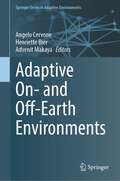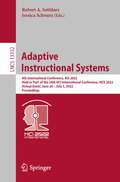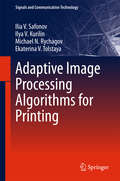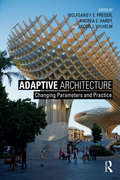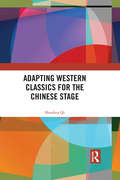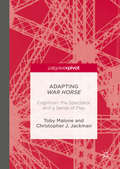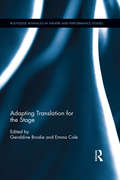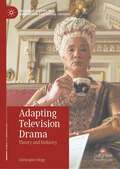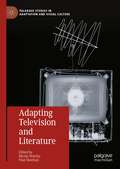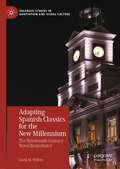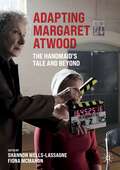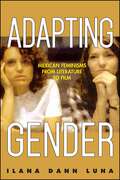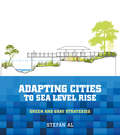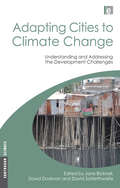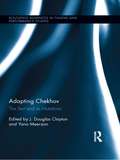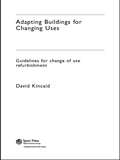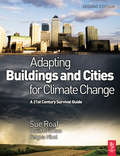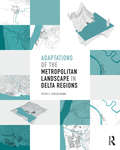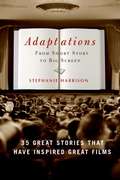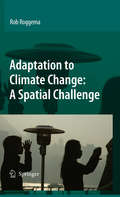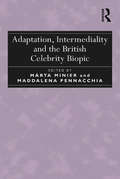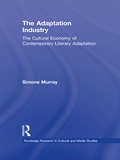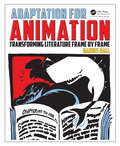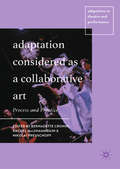- Table View
- List View
Adaptive On- and Off-Earth Environments (Springer Series in Adaptive Environments)
by Angelo Cervone Henriette Bier Advenit MakayaThis volume investigates the challenges and opportunities for designing, manufacturing and operating off-Earth infrastructures in order to establish adaptive human habitats. The adaptive aspects are considered with respect to the development of adequate infrastructures designed to support human activities. Given the limitations in bringing materials from Earth, utilisation of in-situ resources is crucial for establishing and maintaining these infrastructures.Adaptive on-and off-Earth Environments focuses, among other aspects, on the design, production, and operation processes required to build and maintain such off-Earth infrastructures, while heavily relying on In-Situ Resource Utilisation (ISRU). Such design, production, and operation processes integrate cyber-physical approaches developed and tested on Earth. The challenge is to adapt on-Earth approaches to off-Earth applications aiming at technology advancement and ultimately transfer from on- to off-Earth research. Thischallenge is addressed with contributions from various disciplines ranging from power generation to architecture, construction, and materials engineering involving ISRU for manufacturing processes. All chapters, related to these disciplines, are structured with an emphasis on computing and adaptivity of on-Earth technology to off-Earth applications and vice versa to serve society at large.
Adaptive Instructional Systems: 4th International Conference, AIS 2022, Held as Part of the 24th HCI International Conference, HCII 2022, Virtual Event, June 26 – July 1, 2022, Proceedings (Lecture Notes in Computer Science #13332)
by Robert A. Sottilare Jessica SchwarzThis book constitutes the refereed proceedings of the 4th International Conference on Adaptive Instructional Systems, AIS 2022, held as part of the 23rd International Conference, HCI International 2022, which was held virtually in June/July 2022.The total of 1271 papers and 275 posters included in the HCII 2022 proceedings was carefully reviewed and selected from 5487 submissions. The AIS 2022 proceedings were organized in the following topical sections: Learner Modeling and State Assessment for Adaptive Instructional Decisions; Adaptation Design to Individual Learners and Teams; Design and Development of Adaptive Instructional Systems; Evaluating the Effectiveness of Adaptive Instructional Systems.
Adaptive Image Processing Algorithms for Printing (Signals and Communication Technology)
by Ilia V. Safonov Ilya V. Kurilin Michael N. Rychagov Ekaterina V. TolstayaThis book presents essential algorithms for the image processing pipeline of photo-printers and accompanying software tools, offering an exposition of multiple image enhancement algorithms, smart aspect-ratio changing techniques for borderless printing and approaches for non-standard printing modes. All the techniques described are content-adaptive and operate in an automatic mode thanks to machine learning reasoning or ingenious heuristics. The first part includes algorithms, for example, red-eye correction and compression artefacts reduction, that can be applied in any photo processing application, while the second part focuses specifically on printing devices, e. g. eco-friendly and anaglyph printing. The majority of the techniques presented have a low computational complexity because they were initially designed for integration in system-on-chip. The book reflects the authors' practical experience in algorithm development for industrial R&D.
Adaptive Architecture: Changing Parameters and Practice
by Wolfgang F. E. Preiser Andrea E. Hardy Jacob J. WilhelmThe constant in architecture's evolution is change. Adaptive Architecture explores structures, or environments that accommodate multiple functions at the same time, sequentially, or at periodically recurring events. It demonstrates how changing technological, economic, ecological and social conditions have altered the playing field for architecture from the design of single purpose structures to the design of interacting systems of synergistically interdependent, distributed buildings. Including contributors from the US, UK, Japan, Australia, Germany and South Africa, the essays are woven into a five-part framework which provides a broad and unique treatment of this important and timely issue.
Adapting Western Classics for the Chinese Stage
by Shouhua QiAdapting Western Classics for the Chinese Stage presents a comprehensive study of transnational, transcultural, and translingual adaptations of Western classics from the turn of the twentieth century to present-day China in the age of globalization. Supported by a wide range of in-depth research, this book Examines the complex dynamics between texts, both dramatic and socio-historical; contexts, both domestic and international; and intertexts, Western classics and their Chinese reinterpretations in huaju and/or traditional Chinese xiqu; Contemplates Chinese adaptations of a range of Western dramatic works, including Greek, English, Russian, and French; Presents case studies of key Chinese adaptation endeavors, including the 1907 adaptation of Uncle Tom’s Cabin by the Spring Willow Society and the 1990 adaptation of Hamlet by Lin Zhaohua; Lays out a history of uneasy convergence of East and West, complicated by tensions between divergent sociopolitical forces and cultural proclivities. Drawing on disciplines and critical perspectives, including theatre and adaptation studies, comparative literature, translation studies, reception theory, post-colonialism, and intertextuality, this book is key reading for students and researchers in any of these fields.
Adapting War Horse: Cognition, the Spectator, and a Sense of Play
by Toby Malone Chris JackmanThis book analyses the success and adaptation of Michael Morpurgo's novel War Horse to stage, radio, live events, and feature film, in different cultures, on tours, and in translation. In under a decade, War Horse has gone from obscure children's novel to arguably one of the world's most recognisable theatrical brands, thanks to innovative puppet designs from South Africa's Handspring Puppet Company in an acclaimed stage production from the National Theatre of Great Britain. With emphasis on embodied spectatorship, collaborative meaning-making, and imaginative 'play,' this book generates fresh insights into the enduring popularity of the franchise's eponymous protagonist, Joey, offering the most in-depth study of War Horse to date.
Adapting Translation for the Stage (Routledge Advances in Theatre & Performance Studies)
by Geraldine Brodie Emma ColeTranslating for performance is a difficult – and hotly contested – activity. Adapting Translation for the Stage presents a sustained dialogue between scholars, actors, directors, writers, and those working across these boundaries, exploring common themes and issues encountered when writing, staging, and researching translated works. It is organised into four parts, each reflecting on a theatrical genre where translation is regularly practised: The Role of Translation in Rewriting Naturalist Theatre Adapting Classical Drama at the Turn of the Twenty-First Century Translocating Political Activism in Contemporary Theatre Modernist Narratives of Translation in Performance A range of case studies from the National Theatre’s Medea to The Gate Theatre’s Dances of Death and Emily Mann’s The House of Bernarda Alba shed new light on the creative processes inherent in translating for the theatre, destabilising the literal/performable binary to suggest that adaptation and translation can – and do – coexist on stage. Chronicling the many possible intersections between translation theory and practice, Adapting Translation for the Stage offers a unique exploration of the processes of translating, adapting, and relocating work for the theatre.
Adapting Television Drama: Theory and Industry (Palgrave Studies in Adaptation and Visual Culture)
by Christopher HoggThis book explores adaptation in its various forms in contemporary television drama. It considers the mechanics of adaptation as an ever-more prevalent form of production, most notably in the reworking of literary sources for television. It also explores the broader process through which the television industry as a whole is currently making necessary adaptations in how it tells stories, especially in relation to important concerns of equality, diversity and inclusion. Offering and analysing 16 original interviews with leading British television producers, writers, directors, production designers, casting directors and actors, and with a particular focus on female and/or minority-ethnic industry perspectives, the book examines some of the key professional and creative approaches behind television adaptations today. The book connects these industry insights to the existing conceptual and critical frameworks of television studies and adaptation studies, illuminating the unique characteristics of television adaptation as a material mode of production, and revealing television itself as an inherently adaptive artform.
Adapting Television and Literature (Palgrave Studies in Adaptation and Visual Culture)
by Blythe Worthy Paul SheehanAdapting Television and Literature is an incisive collection of essays that explores the growing sub-category of television adaptations of literature and poetics. Each chapter questions inflexible notions of film / literature and adaptation / intertext, focusing judiciously on emergent or overlooked media and literary forms. These lines of enquiry embrace texts both within and beyond ‘adaptation proper’, to reveal the complex relationships between literary works, television adaptations, and related dialogues of textual interconnectivity. Adapting Television and Literature proposes, in particular, a ‘re-seeing’ of four genres pivotal to television and its history: caustic comedy, which claims for itself more freedoms than other forms of scripted television; auteurist outlaw drama, an offbeat, niche genre that aligns a fixation on lawbreakers with issues of creative control; young adult reinventions that vitalise this popular, yet under-examined area of television studies; and transcultural exchanges, which highlight adaptations beyond the white, Anglo-American programming that dominates ‘peak TV’. Through these genres, Adapting Television and Literature examines the creative resources of adaptation, plotting future paths for enquiries into television, literature and transmedial storytelling.
Adapting Spanish Classics for the New Millennium: The Nineteenth-Century Novel Remediated (Palgrave Studies in Adaptation and Visual Culture)
by Linda M. WillemThe twenty-first-century's turn away from fidelity-based adaptations toward more innovative approaches has allowed adapters from Spain, Argentina, and the United States to draw upon Spain's rich body of nineteenth-century classics to address contemporary concerns about gender, sexuality, race, class, disability, celebrity, immigration, identity, social justice, and domestic violence. This book provides a snapshot of visual adaptations in the first two decades of the new millennium, examining how novelistic material from the past has been remediated for today's viewers through film, television, theater, opera, and the graphic novel. Its theoretical approach refines the binary view of adapters as either honoring or opposing their source texts by positing three types of adaptation strategies: salvaging (which preserves old stories by giving them renewed life for modern audiences), utilizing (which draws upon a pre-existing text for an alternative purpose, building upon the story and creating a shift in emphasis without devaluing the source material), and appropriation (which involves a critique of the source text, often with an attempt to dismantle its authority). Special attention is given to how adapters address audiences that are familiar with the source novels, and those that are not. This examination of the vibrant afterlife of classic literature will be of interest to scholars and educators in the fields of adaptation, media, Spanish literature, cultural studies, performance, and the graphic arts.
Adapting Margaret Atwood: The Handmaid's Tale and Beyond (Palgrave Studies in Adaptation and Visual Culture)
by Shannon Wells-Lassagne Fiona McMahonThis book engages with Margaret Atwood’s work and its adaptations. Atwood has long been appreciated for her ardent defence of Canadian authors and her genre-bending fiction, essays, and poetry. However, a lesser-studied aspect of her work is Atwood’s role both as adaptor and as source for adaptation in media as varied as opera, television, film, or comic books. Recent critically acclaimed television adaptations of the novels The Handmaid’s Tale (Hulu) and Alias Grace (Amazon) have rightfully focused attention on these works, but Atwood’s fiction has long been a source of inspiration for artists of various media, a seeming corollary to Atwood’s own tendency to explore the possibilities of previously undervalued media (graphic novels), genres (science-fiction), and narratives (testimonial and historical modes). This collection hopes to expand on other studies of Atwood’s work or on their adaptations to focus on the interplay between the two, providing an interdisciplinary approach that highlights the protean nature of the author and of adaptation.
Adapting Gender: Mexican Feminisms from Literature to Film (SUNY series in Latin American Cinema)
by Ilana Dann LunaAdapting Gender offers a cogent introduction to Mexico's film industry, the history of women's filmmaking in Mexico, a new approach to adaptation as a potential feminist strategy, and a cultural history of generational changes in Mexico. Ilana Dann Luna examines how adapted films have the potential to subvert not only the intentions of the source text, but how they can also interrupt the hegemony of gender stereotypes in a broader socio-political context. Luna follows the industrial shifts that began with Salinas de Gortari's presidency, which made the long 1990s the precise moment in which subversive filmmakers, particularly women, were able to participate more fully in the industry and portrayed the lived experiences of women and non-gender-conforming men. The analysis focuses on Busi Cortés's El secreto de Romelia (1988), an adaptation of Rosario Castellanos's short novel El viudo Román (1964); Sabina Berman and Isabelle Tardán's Entre Pancho Villa y una mujer desnuda (1996), an adaptation of Berman's own play, Entre Villa y una mujer desnuda (1992); Guita Schyfter's Novia que te vea (1993), an adaptation of Rosa Nissán's eponymous novel (1992); and Jaime Humberto Hermosillo's De noche vienes, Esmeralda (1997), an adaptation of Elena Poniatowska's short story "De noche vienes" (1979). These adapted texts established a significant alternative to monolithic notions of national (gendered) identity, while critiquing, updating, and even queering, notions of feminism in the Mexican context.
Adapting Cities to Sea Level Rise: Green and Gray Strategies
by Stefan AlIn 2012, Hurricane Sandy floods devastated coastal areas in New York and New Jersey. In 2017, Harvey flooded Houston. Today in Miami, even on sunny days, king tides bring fish swimming through the streets in low-lying areas. These types of events are typically called natural disasters. But overwhelming scientific consensus says they are actually the result of human-induced climate change and irresponsible construction inside floodplains.As cities build more flood-management infrastructure to adapt to the effects of a changing climate, they must go beyond short-term flood protection and consider the long-term effects on the community, its environment, economy, and relationship with the water. Adapting Cities to Sea Level Rise, by infrastructure expert Stefan Al, introduces design responses to sea-level rise, drawing from examples around the globe. Going against standard engineering solutions, Al argues for approaches that are integrated with the public realm, nature-based, and sensitive to local conditions and the community. He features design responses to building resilience that creates new civic assets for cities. For the first time, the possible infrastructure solutions are brought together in a clear and easy-to-read format.The first part of the book looks at the challenges for cities that have historically faced sea-level rise and flooding issues, and their response in resiliency through urban design. He presents diverse case studies from New Orleans to Ho Chi Minh to Rotterdam, and draws best practices and urban design typologies for the second part of the book. Part two is a graphic catalogue of best-practices or resilience strategies. These strategies are organized into four categories: hard protect, soft protect, store, and retreat. The benefits and challenges of each strategy are outlined and highlighted by a case study showing where that strategy has been applied.Any professional or policymaker in coastal areas seeking to protect their communities from the effects of climate change should start with this book. With the right solutions, Al shows, sea-level rise can become an opportunity to improve our urban areas and landscapes, rather than a threat to our communities.
Adapting Cities to Sea Level Rise: Green and Gray Strategies
by Stefan Al Edgar WesterhofAs cities build more flood-management infrastructure to adapt to the effects of a changing climate, they must go beyond short-term flood protection and consider the long-term effects on the community, its environment, economy, and relationship with the water.Adapting Cities to Sea Level Rise, by infrastructure expert Stefan Al, introduces design responses to sea-level rise, drawing from examples around the globe. Going against standard engineering solutions, Al argues for approaches that are integrated with the public realm, nature-based, and sensitive to local conditions and the community. He features design responses to building resilience that creates new civic assets for cities.With the right solution, Al shows, sea-level rise can become an opportunity to improve our urban areas and landscapes, rather than a threat to our communities.
Adapting Cities to Climate Change: Understanding and Addressing the Development Challenges (Earthscan Climate Ser.)
by Jane Bicknell David Dodman David SatterthwaiteThis volume brings together, for the first time, a wide-ranging and detailed body of information identifying and assessing risk, vulnerability and adaptation to climate change in urban centres in low- and middle-income countries. Framed by an overview of the main possibilities and constraints for adaptation, the contributors examine the implications of climate change for cities in Africa, Asia and Latin America, and propose innovative agendas for adaptation. The book should be of interest to policy makers, practitioners and academics who face the challenge of addressing climate change vulnerability and adaptation in urban centres throughout the global South. Published with E&U and International Institute for Environment and Development
Adapting Chekhov: The Text and its Mutations (Routledge Advances in Theatre & Performance Studies #23)
by J. Douglas Clayton Yana MeerzonThis book considers the hundred years of re-writes of Anton Chekhov’s work, presenting a wide geographical landscape of Chekhovian influences in drama. The volume examines the elusive quality of Chekhov’s dramatic universe as an intricate mechanism, an engine in which his enigmatic characters exist as the dramatic and psychological ciphers we have been de-coding for a century, and continue to do so. Examining the practice and the theory of dramatic adaptation both as intermedial transformation (from page to stage) and as intramedial mutation, from page to page, the book presents adaptation as the emerging genre of drama, theatre, and film. This trend marks the performative and social practices of the new millennium, highlighting our epoch’s need to engage with the history of dramatic forms and their evolution. The collection demonstrates that adaptation as the practice of transformation and as a re-thinking of habitual dramatic norms and genre definitions leads to the rejuvenation of existing dramatic and performative standards, pioneering the creation of new traditions and expectations. As the major mode of the storytelling imagination, adaptation can build upon and drive the audience’s horizons of expectations in theatre aesthetics. Hence, this volume investigates the original and transformative knowledge that the story of Chekhov’s drama in mutations offers to scholars of drama and performance, to students of modern literatures and cultures, and to theatre practitioners worldwide.
Adapting Buildings for Changing Uses: Guidelines for Change of Use Refurbishment
by David KincaidAdapting Building for Changing Uses discusses the comprehensive refurbishment of buildings to enable them to be used for purposes different to those originally intended.For those involved in the often risky business of conversion of buildings from one type of use to another, Adapting Building for Changing Uses provides secure guidance on which uses may be best suited to a particular location. This guidance is based on a unique decision tool, the "Use Comparator", which was developed through research carried out at UCL in the mid 1990's. The "Use Comparator" compares the physical and locational characteristics of a building with the characteristics best suited to various types of use. A total of 77 targeted types of use are evaluated, in contrast to the 17 uses normally considers by regulatory planners.Adapting Building for Changing Uses also identifies the key problems experienced by building managers involved in assembling the coalition of Producers, Investors, Marketeers, Regulators and Users, which makes the key decisions in "Adaptive Reuse". The book explores the differing perceptions and attitudes of these key decision agents to matters such as cost, value, risk and robustness, and offers advice on how to avoid the potential for project failure that these differences present.
Adapting Buildings and Cities for Climate Change: A 21st Century Survival Guide
by David Crichton Fergus Nicol Sue RoafFrom the bestselling author of Ecohouse, this fully revised edition of Adapting Buildings and Cities for Climate Change provides unique insights into how we can protect our buildings, cities, infra-structures and lifestyles against risks associated with extreme weather and related social, economic and energy events. Three new chapters present evidence of escalating rates of environmental change. The authors explore the growing urgency for mitigation and adaptation responses that deal with the resulting challenges. Theoretical information sits alongside practical design guidelines, so architects, designers and planners can not only see clearly what problems they face, but also find the solutions they need, in order to respond to power and water supply needs. Considers use of materials, structures, site issues and planning in order to provide design solutions. Examines recent climate events in the US and UK and looks at how architecture was successful or not in preventing building damage. Adapting Buildings and Cities for Climate Change is an essential source, not just for architects, engineers and planners facing the challenges of designing our building for a changing climate, but also for everyone involved in their production and use.
Adaptations of the Metropolitan Landscape in Delta Regions
by Peter C BosselmannAdaptations of the Metropolitan Landscape in Delta Regions is about environmental quality and the long term livability of urban areas. In decades to come, climate change will affect cities everywhere, but nowhere have the effects of climate change already been felt as strongly as in low-lying coastal cities, cities located in large river deltas and near tidal estuaries. This book reflects on the contribution that spatial planning and urban design can make to a complex discussion about how city form and landscapes will need to adapt within metropolitan areas. The book’s focus is on the urban form of three delta regions: the Pearl River Delta in Southern China; the Rhine, Maas, and Scheldt Delta in the Netherlands; and the San Francisco Bay Area in Northern California. The three regions differ greatly, but despite their different political systems, history, culture and locations in three different climate zones, all three regions will be forced to respond to similar issues that will trigger transformations and adaptations to their urban form. Richly illustrated in color with detailed diagrams, models, photographs and sketches, the book is written for students, scholars and practitioners of environmental planning, and designers who need to respond to the future form of cities in light of climate change. For the professions shaping the physical world of cities and regions, the challenge is not only one of designing physical geometries but of social consequences.
Adaptations: 35 Great Stories That Have Inspired Great Films
by Stephanie HarrisonAn Eclectic Collection of Fiction That Inspired Film Memento, All About Eve, Rear Window, Rashomon, and 2001: A Space Odyssey are all well-known and much-loved movies, but what is perhaps a lesser-known fact is that all of them began their lives as short stories. Adaptations gathers together 35 pieces that have been the basis for films, many from giants of American literature (Hemingway, Fitzgerald) and many that have not been in print for decades (the stories that inspired Bringing Up Baby, Meet John Doe, and All About Eve). Categorized by genre, and featuring movies by master directors such as Steven Spielberg, Stanley Kubrick, Robert Altman, Frank Capra, and John Ford, as well as relative newcomers such as Chris Eyre and Christopher Nolan, Adaptations offers insight into the process of turning a short story into a screenplay, one that, when successful, doesn't take drastic liberties with the text upon which it is based, but doesn't mirror its source material too closely either. The stories and movies featured in Adaptations include: *Philip K. Dick's "The Minority Report," which became the 2002 blockbuster directed by Steven Spielberg and starring Tom Cruise *"The Harvey Pekar Name Story" by reclusive graphic artist Harvey Pekar, whose life was the inspiration for American Splendor, winner of the 2003 Sundance Grand Jury Prize *Hagar Wilde's "Bringing Up Baby," the basis of the classic film Bringing Up Baby, anthologized here for the first time ever *"The Swimmer" by John Cheever, an example of a highly regarded story that many feared might prove unadaptable *The predecessor to the beloved holiday classic A Christmas Story, "Red Ryder Nails the Hammond Kid" by Jean Shepherd Whether you're a fiction reader or a film buff, Adaptations is your behind-the-scenes look at the sometimes difficult, sometimes brilliantly successful process from the printed page to the big screen.
Adaptation to Climate Change: A Spatial Challenge
by Rob RoggemaAs it becomes clear that climate change is not easily within the boundaries of the 1990's, society needs to be prepared and needs to anticipate future changes due to the uncertain changes in climate. So far, extensive research has been carried out on several issues including the coastal defence or shifting ecozones. However, the role spatial design and planning can play in adapting to climate change has not yet been focused on. This book illuminates the way adaptation to climate change is tackled in water management, ecology, coastal defence, the urban environment and energy. The question posed is how each sector can anticipate climate change by creating spatial designs and plans. The main message of this book is that spatial design and planning are a very useful tool in adapting to climate change. It offers an integral view on the issue, it is capable in dealing with uncertainties and it opens the way to creative and anticipative solutions. Dealing with adaptation to climate change requires a shift in mindset; from a technical rational way of thinking towards an integral proactive one. A new era in spatial design and planning looms on the horizon.
Adaptation, Intermediality and the British Celebrity Biopic
by Márta Minier Maddalena PennacchiaBeginning with the premise that the biopic is a form of adaptation and an example of intermediality, this collection examines the multiplicity of 'source texts' and the convergence of different media in this genre, alongside the concurrent issues of fidelity and authenticity that accompany this form. The contributors focus on big and small screen biopics of British celebrities from the late twentieth and twenty-first centuries, attending to their myth-making and myth-breaking potential. Related topics are the contemporary British biopic's participation in the production and consumption of celebrated lives, and the biopic's generic fluidity and hybridity as evidenced in its relationship to such forms as the bio-docudrama. Offering case studies of film biographies of literary and cultural icons, including Elizabeth I, Elizabeth II, Diana Princess of Wales, John Lennon, Shakespeare, Jane Austen, Beau Brummel, Carrington and Beatrix Potter, the essays address how British identity and heritage are interrogated in the (re)telling and showing of these lives, and how the reimagining of famous lives for the screen is influenced by recent processes of manufacturing celebrity.
The Adaptation Industry: The Cultural Economy of Contemporary Literary Adaptation (Routledge Research in Cultural and Media Studies)
by Simone MurrayAdaptation constitutes the driving force of contemporary culture, with stories adapted across an array of media formats. However, adaptation studies has been concerned almost exclusively with textual analysis, in particular with compare-and-contrast studies of individual novel and film pairings. This has left almost completely unexamined crucial questions of how adaptations come to be made, what are the industries with the greatest stake in making them, and who the decision-makers are in the adaptation process. The Adaptation Industry re-imagines adaptation not as an abstract process, but as a material industry. It presents the adaptation industry as a cultural economy of six interlocking institutions, stakeholders and decision-makers all engaged in the actual business of adapting texts: authors; agents; publishers; book prize committees; scriptwriters; and screen producers and distributors. Through trading in intellectual property rights to cultural works, these six nodal points in the adaptation network are tightly interlinked, with success for one party potentially auguring for success in other spheres. But marked rivalries between these institutional forces also exist, with competition characterizing every aspect of the adaptation process. This book constructs an overdue sociology of contemporary literary adaptation, never losing sight of the material and institutional dimensions of this powerful process.
Adaptation for Animation: Transforming Literature Frame by Frame
by Hannes RallTalented animation artists often neglect successful storytelling in favor of strong visuals, but now you can have both with this complete guide to adaptation for animation. Veteran independent filmmaker Hannes Rall teaches you how to draw and adapt inspiration from copyright-free materials like fairy tales, myths, and classic literature, making it easier than ever to create your own compelling narrative. Particular focus is given to making the adequate narrative and visual choices when transferring a text from page to screen: How to create a successful adaptation. With sections on subjects like transcultural adaptations, visual poetry and production design, this book is just the right mix of practical advice, lavish illustrations, and industry case studies to give you everything you need to start adapting your story today. Key features: Learn to apply concepts of adapting classic and modern literature for animation in different techniques Exclusive interviews with animation legends Giannalberto Bendazzi, John Canemaker, Ishu Patel and Georges Schwizgebel Lavishly illustrated with 325 color images (mostly never published before) that give thrilling insights into the visual development of award-winning animated adaptations
Adaptation Considered as a Collaborative Art: Process and Practice (Adaptation in Theatre and Performance)
by Bernadette Cronin Rachel MagShamhráin Nikolai PreuschoffThis book examines the processes of adaptation across a number of intriguing case studies and media. Turning its attention from the 'what' to the 'how' of adaptation, it serves to re-situate the discourse of adaptation studies, moving away from the hypotheses that used to haunt it, such as fidelity, to questions of how texts, authors and other creative practitioners (always understood as a plurality) engage in dialogue with one another across cultures, media, languages, genders and time itself. With fifteen chapters across fields including fine art and theory, drama and theatre, and television, this interdisciplinary volume considers adaptation across the creative and performance arts, with a single focus on the collaborative.
